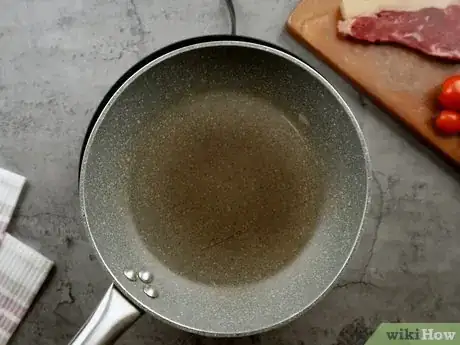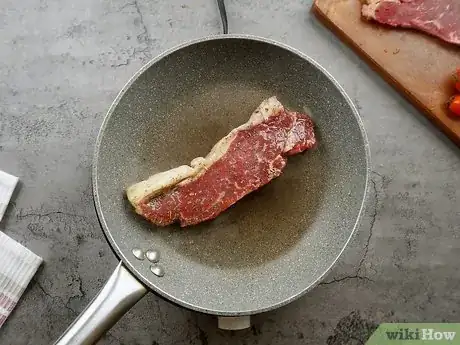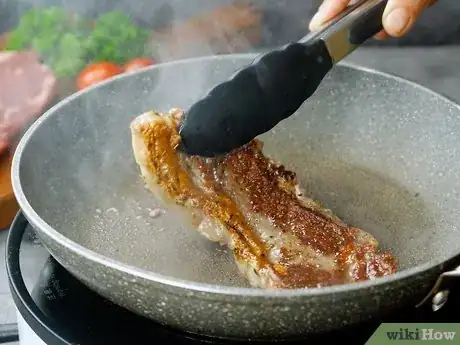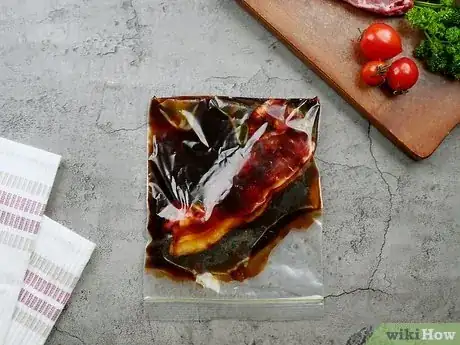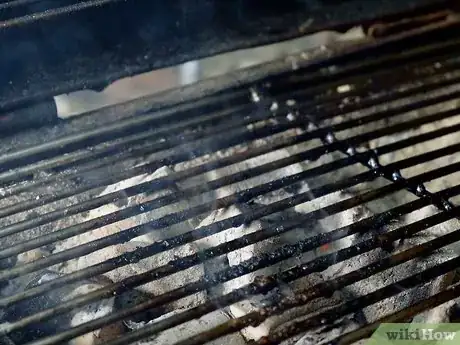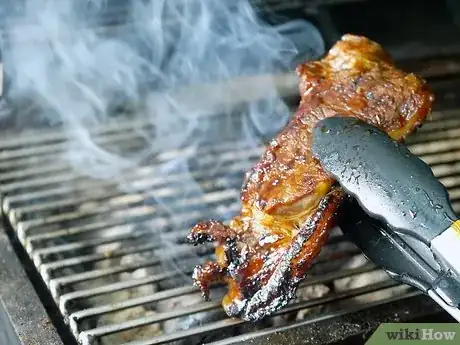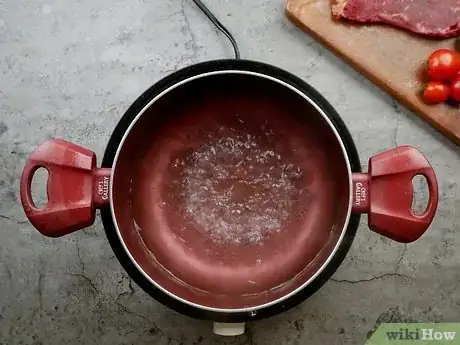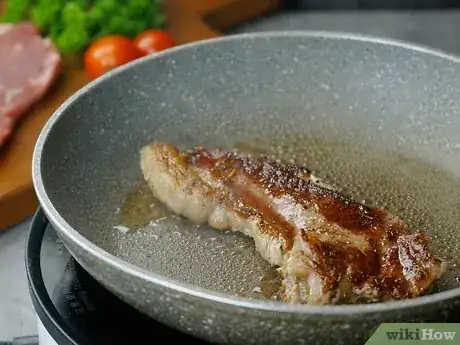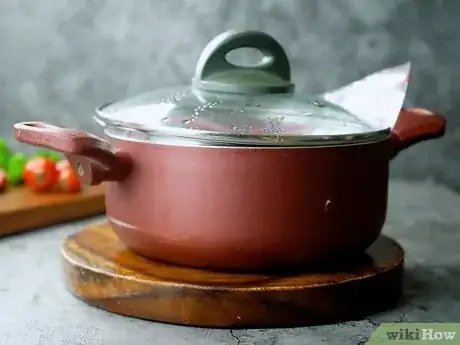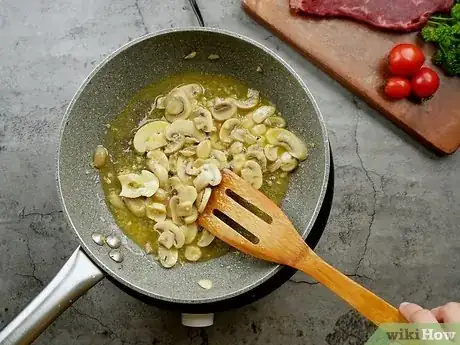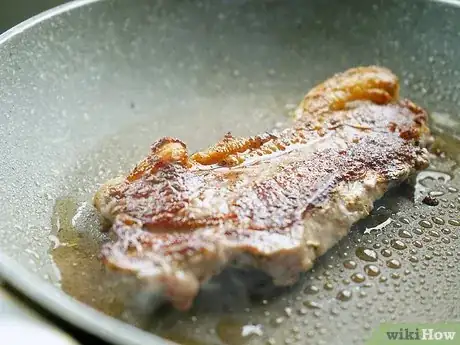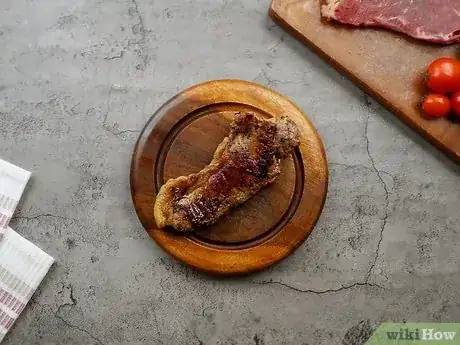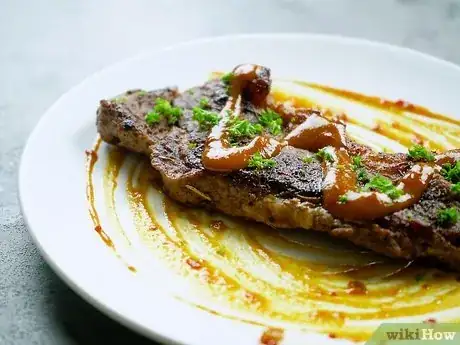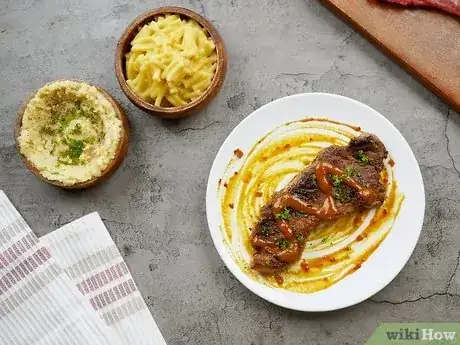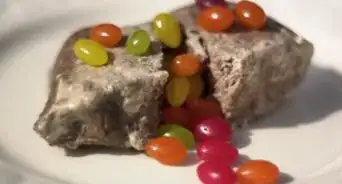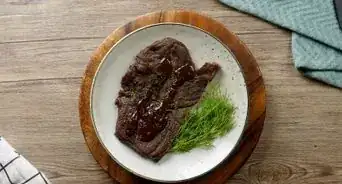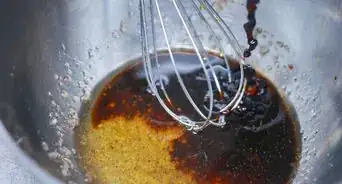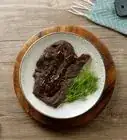This article was co-authored by Ollie George Cigliano. Ollie George Cigliano is a Private Chef, Food Educator, and Owner of Ollie George Cooks, based in Long Beach, California. With over 20 years of experience, she specializes in utilizing fresh, fun ingredients and mixing traditional and innovative cooking techniques. Ollie George holds a BA in Comparative Literature from The University of California, Berkeley, and a Nutrition and Healthy Living Certificate from eCornell University.
There are 7 references cited in this article, which can be found at the bottom of the page.
This article has been viewed 149,146 times.
New York strip steaks are a delicious cut of beef from the tenderloin region of the cow. These steaks are fairly easy to cook — no matter which cooking tools you've got handy, the basic principles of giving the meat a crispy exterior crust and then cooking it all the way through will give you a great-tasting result. Depending on the cooking method you use, it's not hard to get a juicy steak in as little as 20 minutes to half an hour, so get started right away!
Ingredients
- 2 (1-inch thick) boneless New York strip steaks
- 2 tablespoons olive oil
- Salt and pepper to taste
- 2 cloves garlic (minced)
- 1 tablespoon Worcestershire sauce
- 1 tablespoon Balsamic vinegar
- 2 teaspoon Dijon mustard
- 1 tablespoon Soy sauce
- 3 tablespoon Olive oil
- Salt and pepper to taste
- 1 cup clamshell or white mushrooms
- 2 teaspoons olive or vegetable oil
- 2 shallots, diced
- 1 clove garlic, minced
- 2 tablespoons butter
- Salt and pepper to taste
Steps
Making a Simple Pan-Seared Steak
-
1Heat a pan on the stove. The secret to getting a great pan-seared steak is having a hot pan and by only cooking as long as is necessary. The best strip steaks have a crisp, seared exterior that can only be achieved with a piping hot pan, so your first step is to set your pan on your stove and turn the burner to high heat. While you're waiting for your pan to heat up, you can remove your steaks from their packaging and start seasoning them.
- Here's an easy test to see if your pan is hot enough — wet your fingers in the sink and flick the water onto the pan. If the droplets immediately sizzle and evaporate or "dance" across the surface of the pan, it's ready![1]
-
2Season and oil your steaks. As your pan starts to warm, set your steaks on a clean cutting board or platter. Season each side with salt and pepper. The precise amount you use is up to you — some guides, for instance, recommend using a mixture of about 1/4 teaspoons pepper and 1 & 1/2 teaspoons salt for every two steaks. A good rule is to err on the side of using too little salt (after all, you can always add more when the steak is done).
- At this point, you can also add any additional dry seasonings you want. Pre-packaged mixes like Johnny's, etc. are a good choice, as are your own concoctions (for instance, rosemary, thyme, and minced garlic is one common combination).
- After seasoning your steaks, coat each with oil. This is important for getting a crispy sear — the oil essentially "fries" the outer layer of the steak.
Advertisement -
3Add your steaks to the pan. Using a pair of tongs, lay your steaks onto the hot pan. To avoid getting hit by hot juices, lay the steaks away from you, rather than towards you. They should immediately begin to sizzle and crackle — this is a good thing! Move the steaks an inch or so from their original location a few seconds after you add them to the pan to prevent them from sticking, then simply let them cook.
- Some cooking guides recommend letting your steaks warm to room temperature before adding them to a hot pan under the assumption that this helps them cook more evenly. Although letting your steaks warm for 20 to 30 minutes almost certainly won't hurt them, there is some evidence to suggest this claim is just a myth.[2]
-
4Flip after about three or four minutes. The trick to getting an excellent steak from your pan is to only cook each side as long as necessary — cooking too long can make the meat tough. Let your steaks cook in the pan until they develop a dark brown crust on their bottom side flecked with black, charred portions. Depending on the heat of your pan, this usually takes about three to four minutes, though longer or shorter is possible, so keep an eye on your steaks.
- For a well-done steak, you may want to cook a little longer — up to or beyond five minutes. Conversely, for a rare steak, you'll want to flip the steaks a little earlier — as early as two to two and a half minutes.
- The debate about whether to only flip a steak once or whether to flip numerous times is an old one. Conventional wisdom dictates that steaks should only be flipped once to give them the best possible crust. However, many modern steak aficionados disagree, instead recommending frequent flipping.[3]
-
5Allow to cook through and serve! Once you've flipped your steaks over, there's not much left for you to do other than watch it cook (unless you're of the belief that constantly turning the meat makes it taste better). Wait until your steaks have developed a dark crust on the bottom similar to the one on top, then check for signs of done-ness. If your steaks aren't quite done, consider finishing them off in the oven or giving them a few extra minutes in the pan. Below are common signs of a done steak:
- A firm texture at the edges that becomes softer towards the center of the meat
- No red remaining in the center (pinkish to light brown is OK)
- An internal temperature of about 120o to 150o F (49o to 65o C).[4]
Making Grilled Marinated Steak
-
1Mix your marinade. Like many other cuts of meat, New York strip steaks can be given extra flavor by soaking them in a marinade before cooking. We've provided a recipe to one simple but delicious marinade above, but literally hundreds of others will also work well. There aren't any hard and fast rules for making your own marinade, but there are a few basic guidelines that most marinades follow. If you're a novice, try including the following ingredients in your marinade to start with:
- A source of fat. Usually, this is an oil, like vegetable oil, canola oil, olive oil, sesame oil, etc.
- An acid. This can be a citrus juice (like lemon, lime, or orange), wine, vinegar (balsamic, red wine, apple cider, etc.) or another acidic liquid.
- Other seasonings. You can get creative here — anything from Worcestershire sauce to dijon mustard to peanut butter to parsley to garlic to soy sauce can work, depending on whether it pairs well with the other ingredients.
- Salt and pepper to taste.
-
2Soak your steaks before cooking. When your marinade is mixed, put your steaks in an airtight plastic bag or a seal-able fridge container and coat them evenly with the marinade. Let them sit in your fridge for at least two hours so that they're able to soak up the flavor of the marinade — some chefs let their meat marinade overnight to give it an extra dose of flavor.
- It is better to avoid marinating steaks for longer than 24 hours. 12 hours is a sweet spot.
-
3Heat your grill. As with pan-searing, good grilled steaks require a high-temperature initial searing to develop their delicious crust. For this reason, you'll want to start your grill or barbecue well before you plan to cook. Keep the lid close to speed up the grill's heating process.
- For gas grills, pre-heating is easy — simply set one or more burners to "high" and shut the lid for 5 minutes or so.
- For charcoal grills, first, you'll need to light your charcoal, wait for it to flame up, and finally ash over before cooking can begin. This process can take upwards of half an hour, so leave yourself plenty of time. Once your charcoals are ready for cooking, spread them out evenly with a grill tool to prepare the entire grill for cooking.
-
4Add your steaks. Use a grill brush to lightly paint the bars of the grill with olive or vegetable oil, then lay your steaks on the grill surface with a pair of tongs. Allow them to cook much as you would during a pan searing, flipping them after three to five minutes once a suitable crust has formed.
- Once you're familiar with a gas grill, you can usually expect to get consistent results from it. The same can't necessarily be said for charcoal grills, whose cooking times can vary based on how much charcoal is used and what temperature the charcoal is burning at. Thus, you'll want to keep an extra-close eye on your steaks when cooking over charcoal — turn them as soon as you're satisfied with the dark brown crust on the bottom edge.
-
5Remove when done. After your initial turn, allow your steaks to continue cooking for another two to four minutes until they're cooked to your liking. Check for the same signs of done-ness as described above (firm texture at edges, soft in middle, no red inside the meat, etc.) and, if satisfied, remove them from the grill and serve!
- Optionally, you may want to consider painting the steaks with leftover marinade during the cooking process to help them develop a delicious exterior. However, you won't want to apply any marinade once the steaks are finished cooking — since the marinade has come in contact with the raw steaks, this can transfer harmful bacteria to them.
Cooking a Sous Vide Steak
-
1Heat a dutch oven. This method for cooking your New York strip steaks may be unfamiliar to amateur chefs, but, when done right, allows you to get deliciously tender medium-rare steaks very consistently.[5] To start, fill a dutch oven about two-thirds of the way full with water and set it to a medium heat.
- You want the internal temperature of your dutch oven to reach about 130o F (54o C) before you begin to cook your steaks. If your dutch oven doesn't have a built-in thermometer, you can use a candy thermometer by attaching it to the side of the oven.
-
2Brown your steaks in a pan. The problem with cooking steaks in a moist environment like a dutch oven is that there's no way to give them a nice, crispy crust like they'd get on the grill or in a pan. However, there's a way around this — by giving the steaks a quick pan-crisping before (and, as we'll see, after) they're cooked in the dutch oven, we can still give them their desirable crust.
- Season and prepare your steaks and pan exactly as directed for a pan-searing above. However, only cook your steaks one minute per side — remember, you're trying to brown the outsides of the steaks, not cook them through.
-
3Slow-cook the steaks in a plastic bag. Once your steaks have slightly-browned exteriors, place them in a sturdy plastic bag and seal it (you may want to double-bag them to prevent water from leaking in). Remove the air from the bag either with a vacuum-packing tool or by lowering the bag into the water with the seal open, then sealing once the water has forced most of the air out.
- At this point, drop the bag of steaks into the dutch oven and close it. If necessary, raise the heat setting of the oven slightly to bring it back up to 130o. Cook at this temperature for about two to two and a half hours.
- As the steaks cook, periodically check their progress. Move the bag and turn it over about once every hour or so to ensure the meat cooks evenly.
-
4Optionally, prepare a sauce. While you're waiting for steaks to finish cooking, you have plenty of free time to prepare other dishes if you'd like to. One thing you may want to consider doing is making a simple sauce or garnish to put on your steaks once they're finished. For instance, you can make a delicious mushroom garnish by melting a few tablespoons of butter in a saucepan, then tossing in some mushrooms, chopped shallots, and minced garlic for flavor — simply cook the ingredients together until they're flavorful and fragrant.
- You can "eyeball" these ingredients if you'd like — it's hard to add "too much" of any one of them. For precise measurement recommendations, see the ingredients section above.
- For extra flavor, try adding a splash of white whine!
-
5Re-brown the steaks and serve. After a few hours in the dutch oven, the steaks should be deliciously tender and cooked all the way through. At this point, if you'd like, you can toss the steaks back into a hot, oiled pan for one or two minutes on each side to improve their outer crusts. The steaks should now be ready to eat!
- If you made a sauce or garnish, pour a spoonful over each steak before serving it on its plate.
Serving Strip Steak
-
1Allow the meat to rest before cutting into it. Once you remove your steaks from the pan, grill, or oven, you'll probably get a whiff of their delicious aroma and want to bite immediately. Resist this urge! Instead, let your steaks sit under tented tin foil for about ten minutes before you cut into them. You'll be glad you did — steaks that get a chance to rest are slightly moister and more flavorful than those that don't.[6]
- The reason this "resting" tactic works has to do with the way that a piece of meat is constructed at the microscopic level. Meat is made up of tightly-packed muscle fibers — as these fibers cook, they contract, forcing out moisture in the inside of the meat. By giving the meat a chance to cool slightly after cooking, you're allowing the fibers to relax and reabsorb some of this flavorful moisture.
-
2Consider serving with sauce. New York strip steak is a versatile dish that pairs excellently with countless side dishes and garnishes. For a quick solution, try serving your steaks with sauce. Pre-made sauces are ready instantly, while from-scratch sauces can take as little as a few minutes to prepare, making them a great choice if you're in a hurry. Here are just a few sauces that some food experts recommend for strip steak:[7]
- Flavored butter (garlic, parsley, thyme, etc.)
- Barbecue sauce
- Peppercorn sauce
- Pesto
- Red wine reduction
-
3Pair with potatoes for a classic combination. What meal is heartier or more satisfying than steak and potatoes? Lots of potato side dishes pair excellently with steak, making for a complete, filling meal. Try serving some of the following potato sides with your steak:
- French-fried potatoes (fries)
- Baked potatoes
- Scalloped potatoes
- Roasted potatoes
- Mashed potatoes
- Boiled potatoes
-
4Try pairing with another delicious side dish. While potatoes are super-reliable side dishes for steak, they're far from the only things that pair well with it. There are a huge variety of foods that taste great with steak. Here are just a few serving suggestions — note that there are no real limits to what you serve with your steak except the ingredients you have handy:
- Fried/caramelized onions
- Wilted spinach/chard/collard greens
- Macaroni and cheese
- Grilled or fried tomatoes
- Salad
- Roasted vegetables
- Onion rings
- Bruschetta
-
5Finished.
Community Q&A
-
QuestionCan I cook the steak as a roast?
 Community AnswerYes.
Community AnswerYes.
Warnings
- Don't use the same utensils you used to handle the uncooked meat to eat or serve it. This can lead to cross-contamination of disease-causing bacteria.⧼thumbs_response⧽
References
- ↑ http://www.home-ec101.com/use-the-water-test-to-determine-when-your-stainless-pan-is-hot-enough-to-cook/
- ↑ http://www.seriouseats.com/2013/06/the-food-lab-7-old-wives-tales-about-cooking-steak.html
- ↑ https://www.thekitchn.com/why-constant-flipping-is-the-key-to-perfect-grilled-meat-172702
- ↑ http://www.foodnetwork.com/recipes/articles/meat-and-poultry-temperature-guide.html
- ↑ http://allrecipes.com/recipe/sous-vide-new-york-strip-steak/
- ↑ http://www.seriouseats.com/2009/12/how-to-have-juicy-meats-steaks-the-food-lab-the-importance-of-resting-grilling.html
- ↑ http://www.bbcgoodfood.com/howto/guide/what-serve-steak
About This Article
To cook New York strip steak on the stovetop, heat a skillet over high heat. Season each side of your steaks with salt and pepper to taste and add any other dry seasonings you like. Coat the steaks on both sides with olive oil. Splash a drop of water in the pan. If it immediately sizzles, it’s hot enough to start cooking. Place the steaks in the pan and sear them on each side for about 3 to 4 minutes. The steaks are ready to serve when they have a brownish crust on the outside and are pink to light brown in the center, depending on how well done you like them. To learn how to cook New York strip steak on a grill, scroll down!
